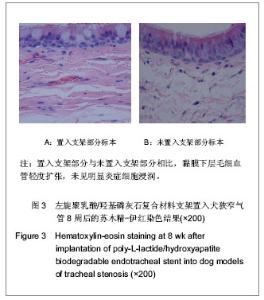Chinese Journal of Tissue Engineering Research ›› 2013, Vol. 17 ›› Issue (29): 5371-5378.doi: 10.3969/j.issn.2095-4344.2013.29.017
Previous Articles Next Articles
Degradable properties of biodegradable composite stents in the trachea
Ma Yong-fu, Liu Yang, Guo Jun-tang, Zhang Tao, Liang Chao-yang
- Department of Thoracic Surgery, Chinese PLA General Hospital, Beijing 100853, China
-
Received:2013-01-14Revised:2013-03-15Online:2013-07-22Published:2013-07-22 -
Contact:Liu Yang, M.D., Professor, Chief physician, Department of Thoracic Surgery, Chinese PLA General Hospital, Beijing 100853, China sunny301x@sina.com -
About author:Ma Yong-fu☆, Studying for doctorate, Attending physician, Department of Thoracic Surgery, Chinese PLA General Hospital, Beijing 100853, China yonfuabc@sina.com -
Supported by:the Nursery Fund of Chinese PLA General Hospital, No. 06MP21*
CLC Number:
Cite this article
Ma Yong-fu, Liu Yang, Guo Jun-tang, Zhang Tao, Liang Chao-yang. Degradable properties of biodegradable composite stents in the trachea[J]. Chinese Journal of Tissue Engineering Research, 2013, 17(29): 5371-5378.
share this article
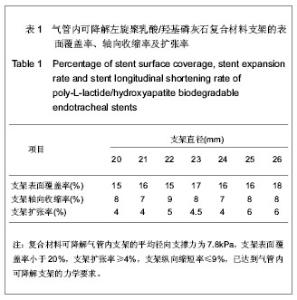
2.1 左旋聚乳酸/羟基磷灰石支架径向支撑力测试结果 将直径20,21,22,23,24,25,26 mm左旋聚乳酸/羟基磷灰石复合材料支架压缩至相应直径13,14,15,16,17,18,19 mm,其径向支撑力分别为7.5,8.2,8.3,8.2,7.7,7.7,8.0 kPa。 左旋聚乳酸/羟基磷灰石复合材料支架平均径向支撑力为7.9 kPa,对应镍钛合金支架平均径向支撑力为7.8 kPa。两组间行均数的t 检验,P=0.388 1,表明左旋聚乳酸/羟基磷灰石复合材料支架与镍钛合金支架径向支撑力比较差异无显著性意义。 2.2 左旋聚乳酸/羟基磷灰石复合支架表面覆盖率、支架轴向收缩率、支架扩张率测试结果 见表1。 解气管内支架的平均径向支撑力为7.8 kPa,支架表面覆盖率小于20%,支架扩张率≥4%,支架纵向缩短率≤9%,已达到气管内可降解支架的力学要求。"
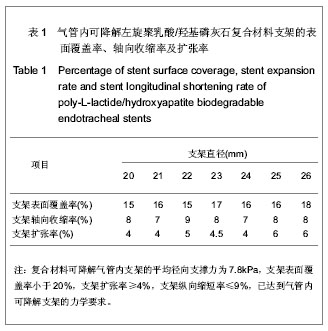
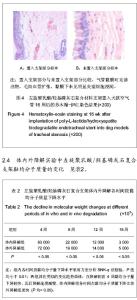
支架置入犬气管16周,苏木精-伊红染色显示置入支架部分与未置入支架部分比较,气管黏膜可见渗出物,毛细血管扩张,黏膜下未见明显炎症细胞浸润,见图4。两组在降解的前4周黏均分子质量下降较快,体内降解组黏均分子质量下降了55%,体外降解组黏均分子质量下降了48%;其后降解速度减慢,在降解第8周,体内降解组黏均分子质量下降了70%,体外降解组黏均分子质量下降了67%;在降解第12周,体内降解组黏均分子质量下降了78%,体外降解组黏均分子质量下降了70%;在降解第16周,体内降解组黏均分子质量下降了80%,体外降解组黏均分子质量下降了73%;它们具有类似的变化趋势曲线。体内降解组的黏均分子质量下降比体外降解组更快,统计学分析证实:两组在各时间点黏均分子质量下降水平比较差异有显著性意义(P均<0.05);两组组内各时间段平均黏均分子质量下降水平比较差异有显著性意义 (P均 < 0.01)。"

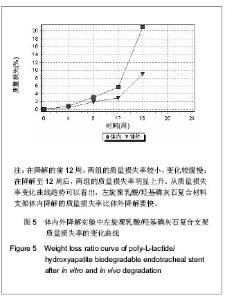
2.5 体内外降解实验中左旋聚乳酸/羟基磷灰石复合支架质量损失率的变化 见图5。分子质量下降意味着高分子链段的断裂,即发生了化学降解,而质量的损失则是材料开始被吸收的标志。降解至第4周,体外降解组的失重率为0.5%,体内降解组的失重率为0.8%;降解至第8周,体外降解组的失重率为1.9%,体内降解组的失重率为3.1%;降解至第12周,体外降解组的失重率为2.9%,体内降解组的失重率为5.7%;降解至第16周,体外降解组的失重率为9%,体内降解组的失重率为21%。在降解的前12周,两组的失重率较小,变化较缓慢,体外降解组的失重率为2.9%,体内降解组的失重率为5.7%;在降解至12周后,两组的失重率明显上升,降解至16周后,体外降解组的失重率为9%,体内降解组失重率为21%。从质量损失率变化曲线趋势可以看出,左旋聚乳酸/羟基磷灰石复合材料支架体内降解的质量损失率比体外降解要快。"
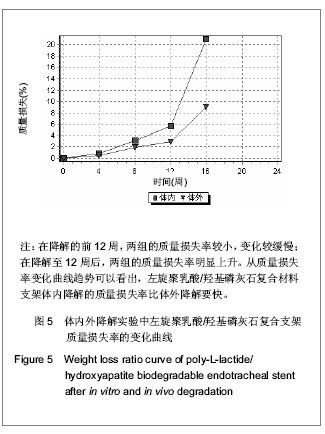
| [1] Bond CJ.Note on the treatment of tracheal stenosis by a new T shaped tracheotomy tube.Lancet.1891;1:539.[2] Langer R,Vacanti JP.Tissue engneering.Since. 1993;250: 920-926.[3] Pollok JM,Vacanti JP,Future materials for foot surgery.Sem in Pediatr Surg.1996;5(3):191-196.[4] Liu Y,Sun Y,Zhou N,et al. Nitinol alloy endotracheal stent for treatment of tracheal stenosis.Chin Med J.1997;11(7):540-542. [5] 刘阳,郭锦芳.镍钛记忆合金支架治疗气管狭窄的实验研究及临床应用[J].中华外科杂志,1993,31(5):267-268.[6] 刘阳,孙玉鹗.镍钛记忆合金气管腔内支架的实验研究[J].中华胸心血管外科杂志,1995,11(4):233-234.[7] 崔福斋.可降解医用介入支架的研发进展[J].国外塑料,2005, 23(11):58-64.[8] Free CE,Vunjak-novakovic G,Iron KJ.Biodegradable polymer scaffoids for tissue engineering. Biotechnology(NY). 1994; 12(7):689-693.[9] Kulkarni RK,Pani KC,Neuman C,et al.Polylatic acid for surgical implants.Archs Surg.1966;6(3):839-843.[10] Miller RA,Brady JM,Cutright DE.Degradation rates of oral resorbable implants(polylactates and polyglycolates):rate modification with changes in PLA/PGA copolymer ratios.J Biomed Mater Res.1977;11(5):711-719.[11] 宋存先.可降解与吸收材料—生物医用材料[M].天津:天津大学出版社,2000:50.[12] Weisberger EC,Eppley BL. Resorbable fixation plates in head and neck surgery.Laryngoscope.1997;107(6):716-719.[13] 祖恩峰,杨青芳,马爱洁,等.生物医用材料聚L-乳酸的生物相容性及降解性能研究[J].中国胶粘剂,2005,14(9):7-10.[14] Verheyen CCPM,Dhert WJA,Petit PLC,et al.In vitro study on the integrity of a hydroxylapatite coating when challenged with staphylococci.J Biomed Mater Res. 1993;27:775-781.[15] Shikinamn Y,Hata K,Okunu M.Ultra-high-strength resorbable implantsmade from bioactive ceramic particles/polylactide composites. Biocramic Proc Int Symp CeramMed.1996; 9: 391-394.[16] Jones NL,Williams DF. Poly [L-Lactide] and Poly[L-Lactide] Ceramic filled Composites: A Long Term in- vivo / in-vitro Degradation Study. Trans.5th world Biomaterials congress. Toronto.1996,Ⅱ:441.[17] 江东亮,漆宗能.纳米复合材料-复合材料[J].天津:天津科技大学出版社,2000:262-276.[18] Skavtsas VI.Biomaterials and bone mechanotransduction. Biomaterials.2001;22(19):2581-2593.[19] Suchanek WL,Shuk P,Byrappa K,et al. Mechanochemical-hydrothermal synthesis of carbonated apatite powders at room temperature.Biomaterials.2002;23: 699-714.[20] Liu Q,Win JR,Bakker D,et al.Polyacids as bonding agents in hydroxyapatite polyester-ether (polyactiveTM30/70) composites.J Mater Sci Mater Med.1998;9:23-30.[21] Horenstein LA.Chromosomal speciation and phenotypic evolution in the house mouse.Micro Tropical Med.2003; 275:99-112.[22] Feng LY,Li SP,Yan YH.The Effect of CaCO3 and TiO2 Nanometer Particles on A549 and L929 Cells.Biocermics. 2000;13:325-328.[23] 夏东,刁路明,杨飞,等.无机纳米粒子对人肺癌细胞A549和小鼠成纤维细胞L929生物学特性研究[J].湖北医科大学学报,2000, 21(2):109-111.[24] Kim YH,Park SW,Lee CW,et al.Comparison of sirolimus-eluting stent, paclitaxel-eluting stent, and bare metal stent in the treatment of long coronary lesions. Catheter Cardiovasc Interv.2006;67(2):181-187.[25] 李毅,张佩华,王文祖,等.新型针织结构人工气管支架的开发及其力学性能初探[J].产业用纺织品,2002,20(12):23-26.[26] Stack RS.Biodegradable systems.In,Bake RW,ed. Controlled release of biologically active agents.New York:John Wiley and Sons.1987:84.[27] Swaua T.Short and long-term vascular tissue response in the Duke bioabsorbable stent.JACC.1993;21(suppl):484.[28] Lincoff AM,Furst JG,Ellis SG,et al.Sustained local delivery of dexamethasone by a novel intravascular eluting stent to prevent restenosis in the porcine coronary injury model.J Am Coll Cardiol.1997;29:808-816.[29] Yamawaki T,Shimokawa H,Kozai T,et al.Intramural delivery of a specific tyrosine kinase inhibitor with biodegradable stent suppresses the restenotic changes of the coronary artery in pigs in vivo.J Am Coll Carddiol.1998;32:780-786.[30] Tamai H, Igaki K,Kyo E,et al.Initial and 6-month results of biodegradable poly-l-lactic acid coronary stents in humans. Circulation.2000;102:399-404.[31] Korpela A,Aarnio P,Sariola H,et al.Bioabsorbable self-reinforced poly-L-lactide, metallic and silicone stents in the management of experimental tracheal stenosis.Chest. 1999;115(2):490-495. [32] Leenslag JW,Penning AJ,Bos RRM,et al.Resorbable materials of poly (L-lactide) VI.Plates and screws for internal fracture. Biomaterials.1987;8: 311-314.[33] 刘建伟,赵强.万昌秀.医用聚乳酸体内降解机理及应用研究进展[J].航天医学与医学工程,2001,14(4):308-312.[34] 顾其胜,侯春林,徐政.实用生物医用材料学[M].上海:上海科学技术出版社,2005:87.[35] 吴兰亭,沈正荣,朱家蕙,等.DL-聚乳酸微球大鼠体内的降解[J].生物医学工程学杂志,1994,11(2):98.[36] Martinez J,Sanchez T,Moreno JJ. Regulation of prostaglandin E2 production by the superoxide radical and nitric oxide in mouse peritoneal macrophages. Free Radic Res.2000;32(4): 303-311.[37] Rose ML,Rusyn I,Bojes HK,et al.Role of Kupffer cells and oxidants in signaling peroxisome proliferator-induced hepatocyte proliferation.Mutat Res.2000; 448(2):179-192.[38] Chong IW,Lin SR,Hwang JJ,et al.Expression and regulation of macrophage inflammatory protein-2 gene by vanadium in mouse macrophages. Inflammation.2000;24(2):127-139. [39] Li SM,Mc Carthy S.Further investigations on the hydrolytic degradation of poly(DL-lactide).Biomaterials.1999;20(1): 35-44. |
| [1] | Yao Guan-feng, Wang Xin-jia, Luo Bin, Wang Wei-dong, Zeng Ji-can. Combined therapy of implants internal fixation and Halo-vest external fixation for the treatment of subaxial cervical fracture-dislocation [J]. Chinese Journal of Tissue Engineering Research, 2013, 17(35): 6351-6356. |
| [2] | Wang Min, Lan Ya, Hu Hao, Shi Yong-quan, Han Ying, Zhou Xin-min. In vitro establishment of a three-dimensional hepatocyte culture system using collagen hydrogel as scaffolds [J]. Chinese Journal of Tissue Engineering Research, 2013, 17(29): 5323-5330. |
| [3] | Xie Ming-quan, Liu Hui-juan, Li Ping, Li Yu-min. Preparation and properties for magnetic/pH double sensitive hydrogel beads carrying carbamazepine [J]. Chinese Journal of Tissue Engineering Research, 2013, 17(29): 5337-5344. |
| [4] | Bao Yu-cheng, Zhang Wen-long, Wang Yong, Zhang Jie, Wang Yong-mei. Dual-drug sustained-release carrier: Preparation and performance [J]. Chinese Journal of Tissue Engineering Research, 2013, 17(29): 5345-5350. |
| [5] | Lu Feng, Zhang Hong-tu, Ma Shu-you. Drug release characteristics of gatifloxacin-poly sebacic anhydride local controlled release system [J]. Chinese Journal of Tissue Engineering Research, 2013, 17(29): 5351-5356. |
| [6] | Xian Yuan-fang, Wang Wen-ting, Yu Wei, Tu Li-hui, Wang Sheng-hai, Zou Cheng, Min Xiao-feng. Preparation of gelatin-magnetic micro-capsules by condensation method [J]. Chinese Journal of Tissue Engineering Research, 2013, 17(29): 5357-5363. |
| [7] | Wei Peng-xiang, Li Dan-qing, Zhou Yu-jia, Liu Jia-lin, Wang Lei. Artificial dura materials in neurosurgical procedures: An analysis of 100 cases [J]. Chinese Journal of Tissue Engineering Research, 2013, 17(29): 5415-5420. |
| [8] | Yuan Liang-liang, Liang Peng . Structural characteristics and advantages of a self-assembling peptide nanofiber scaffold [J]. Chinese Journal of Tissue Engineering Research, 2013, 17(29): 5379-5386. |
| [9] | Wu Tong, Huang Chen, Mo Xiu-mei. A new vascular tissue engineering material: Electrospun small-diameter nanofibous scaffolds [J]. Chinese Journal of Tissue Engineering Research, 2013, 17(29): 5387-5394. |
| [10] | Li Wen-cheng. Antibiotic bone cement and renovation after artificial joint replacement [J]. Chinese Journal of Tissue Engineering Research, 2013, 17(29): 5409-5414. |
| [11] | Yao Jin-feng, Zhang Xiao-wei, Zhou Qi, Zheng Cang-shang, Liang Zhi-gang, Bao Chong-yun. Ectopic bone formation in adipose-derived mesenchymal stem cell-seeded osteoinductive calcium phosphate scaffolds [J]. Chinese Journal of Tissue Engineering Research, 2013, 17(29): 5261-5268. |
| [12] | Ye Peng, Tian Ren-yuan, Huang Wen-liang, Ma Li-kun, Deng Jiang. Silk fibroin/chitosan/nano hydroxyapatite complicated scaffolds for bone tissue engineering [J]. Chinese Journal of Tissue Engineering Research, 2013, 17(29): 5269-5274. |
| [13] | Yin Xiao-peng, Xu Hui-fen, He Hui-yu. Comparison of the biocompatibility of three kinds of antigen-extracted xenogeneic cancellous bone matrices [J]. Chinese Journal of Tissue Engineering Research, 2013, 17(29): 5275-5281. |
| [14] | Xie Hui, Yang Fei, Zhao De-wei, Wang Ben-jie, Cui Da-ping, Wang Wei, Huang Shi-bo. Chondrocyte differentiation of dog bone marrow mesenchymal stem cells co-cultured with Bio-gide collagen membrane in vitro [J]. Chinese Journal of Tissue Engineering Research, 2013, 17(29): 5282-5289. |
| [15] | Ma Lu-ping, Zhong Liang-jun, Zhang Yuan-ming, Zhang Yuan, Zhang Peng-tao. Periodontal ligament cells from miniature swine grow on a hydroxyapatite scaffold [J]. Chinese Journal of Tissue Engineering Research, 2013, 17(29): 5290-5295. |
| Viewed | ||||||
|
Full text |
|
|||||
|
Abstract |
|
|||||
